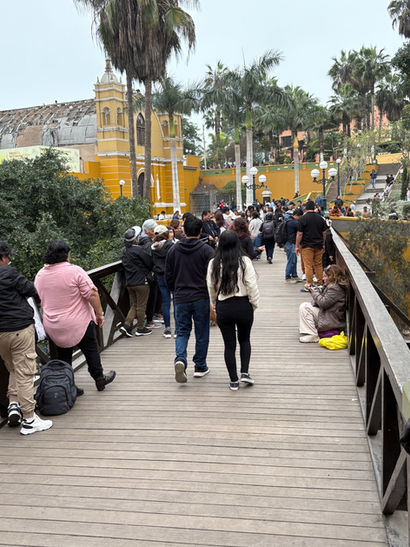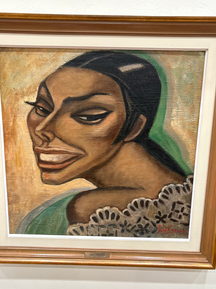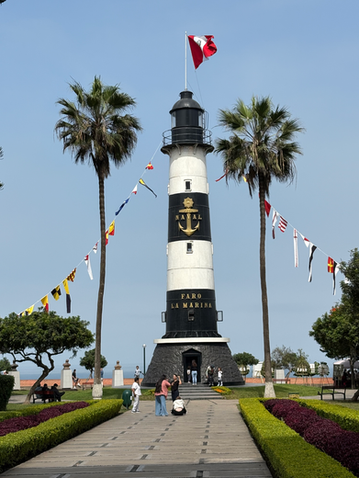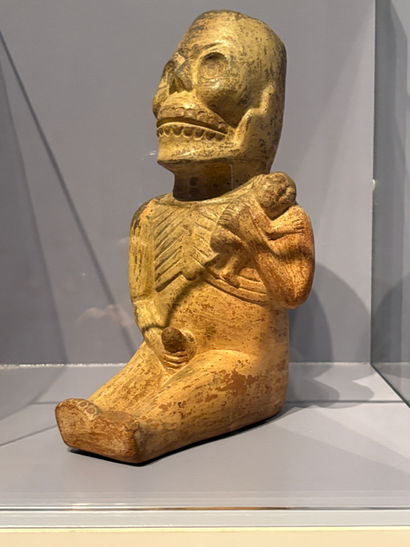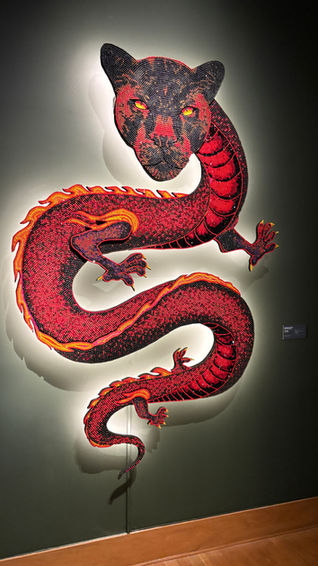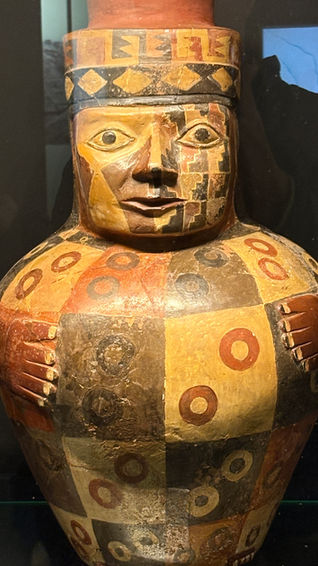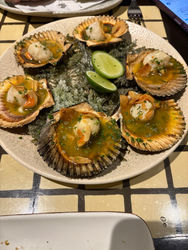
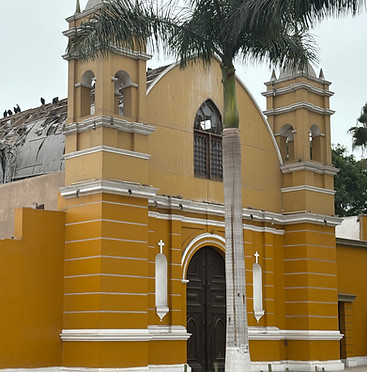

South to Peru
We began in Lima, the capital of Peru. Lima’s history is astonishingly deep, with people living here for at least 10,000 years and cultures like the Lima, Wari, Ichma, and Inca leaving temples, pyramids, and sacred Huacas behind. We arrived in winter, so the days were generally cool enough to need a sweater and often cloudy.
The Inca Empire was the largest in the Americas, stretching 2,500 miles along the Andes, until everything changed in the 1530s when Pizarro and the Spaniards arrived—bringing not only new power and religion but also hardship.
European diseases and forced labor decimated the native population, and Catholic missionaries sought to replace Andean traditions by banning rituals and building churches on top of sacred Huacas.
Yet, people found ways to keep their culture alive, often blending their spiritual practices with the new faith. The city grew into Spain’s stronghold on the Pacific, and after independence in 1821, Peru’s borders shifted for over a century—mainly due to lost conflicts with neighboring countries—before finally settling in 1942, giving shape to the country we know today.
We found Lima to be a beautiful mix of architectural styles, with colonial-era buildings featuring ornate balconies and courtyards, grand 19th- and 20th-century buildings, and modern skyscrapers in districts like Miraflores and San Isidro with contemporary glass-and-steel design. The city has over 40 districts, each supposedly with its own character, and churches with the baroque, neoclassical, and rococo styles of their time, dot the cityscape.



In Miraflores, an upscale residential and shopping area, we had a room overlooking the cliffs and the Pacific Ocean. We enjoyed several walks along the beautiful cliffs, where numerous parks and winding paths overlook the crashing waves below. Surfers rode the swells, their colorful boards darting across the water. It was a perfect spot to stroll, enjoy gardens and sculptures, feel the ocean breeze, and admire the contrast between the city’s modern skyline and the natural beauty below.
We visited Huaca Pucllana, a massive adobe pyramid complex located in central Miraflores. This pyramid has a very different scale than the ones you think of in Egypt. Built on seven staggered platforms from millions of adobe bricks, the size of a textbook, stacked in a bookshelf pattern for strength and earthquake resistance, it served as a ceremonial center and seat of power. Sacrifices were performed to favor the gods, and many graves were found throughout the site. Excavations have revealed that people were interred in tightly folded positions, with their artifacts, in multiple layers of textiles. Because of the arid climate, remains have been remarkably preserved over the centuries. Artifacts include ceramics, jewelry, and other offerings, giving a glimpse into the beliefs and practices of early Lima culture.
As usual on our adventures, we found a few interesting museums to explore. The Museo de Arte de Lima (MALI) showcased a broad collection of Peruvian art, including ceramics excavated from ancient sites, gold and silver jewelry and artifacts, as well as a display of quipu, the knot system used to keep track of information such as census data, tribute, and inventories.
Mark particularly loved the Genoveva Núñez Herrera Museum featuring folk art, including brightly colored multipaneled pieces crafted by the celebrated Cusco artisan Genoveva Núñez Herrera. These intricate dioramas depict everyday Andean life, festivals, and religious rituals, preserving traditional stories while innovating within the form to inspire new generations.
The Larco Museum, housed in an 18th-century vice-royal mansion, spans 5,000 years of Peruvian history. Its collection includes over 45,000 artifacts, with some 4,000 pieces of pre-Columbian pottery uniquely shaped and decorated with intricate scenes of daily life, mythology, and ritual practices. Many vessels feature distinctive designs with a handle and a tube-like spout for pouring liquids in ceremonial or practical contexts.
The pottery varies in size from small, delicate containers to large, elaborately crafted pieces, and remarkably, most are in pristine condition, unlike similar artifacts in other world museums. The collection also includes a fascinating array of erotic pottery, showing that the culture was apparently unashamed of sexuality. Some ceramics are humorous, others depict farming, fishing, or ritual events, offering a vivid, intimate, and occasionally cheeky glimpse into ancient Peruvian society, alongside impressive gold and silver artifacts.
Lima is also a foodie capital, with delicious meals ranging from traditional stews to inventive fusion cuisine. While we didn’t eat at what is currently said to be the world’s top restaurant—a Japanese Peruvian fusion establishment—we savored meals in both little taverns and gourmet restaurants. Fresh ceviche and raw scallops served in the shell were highlights—even Betsey, who usually avoids raw fish, loved them. We also tried traditional Peruvian dishes like Lomo Saltado (a stir fry), Aji de Gallina (shredded chicken stew with rice and potatoes), and enjoyed street foods such as anticuchos (grilled meat skewers), empanadas, and churros.
A walking tour through Lima’s city center took us past the ornate Presidential Palace, Lima Cathedral, and Plaza de Armas, where preparations were underway for Independence Day celebrations. Red and white Peruvian flags decorated every corner, and dancers rehearsed while sound checks echoed through the plaza. We also walked through the Gran Hotel Bolívar, taking in its original lobby, restaurant, and bar, which, though a little dated, reminded us of its glamorous heyday when Hollywood stars and literary giants once visited.


After our trip on the Amazon, we switched hotels and moved to Barranco, Lima’s artsy, bohemian district. The neighborhood is famous for its murals and street art, colonial buildings, narrow streets, and vibrant cafés. The colorful artworks blend social and cultural commentary with abstract and surrealist expressions, constantly evolving as new pieces appear. This district is particularly dog-friendly, with residents often walking their canine companions, day or night, filling streets, parks, and plazas with life. Barranco’s Bridge of Sighs, an iconic footbridge, carries the tradition that if you cross it while holding your breath and make a wish, it will come true—Betsey held her breath across the bridge, hopefully for a healed and functional lower back!
We ended our Lima stay with a private tour to the vast Pachacamac archaeological site, one of Peru’s most important pre-Columbian centers. Stretching across a stark desert plain, Pachacamac is dotted with stone palaces, stepped pyramids, and temples that hint at centuries of layered history. First established around 200 CE by the Lima culture, it was later used by the Wari, Ichma, and eventually the Incas. Revered as a sacred religious center, the site was dedicated to the oracle and deity of creation and earthquakes, drawing pilgrims from far and wide.
Among its highlights are the Temple of the Sun, Temple of the Moon, and the Temple of the Painted Terraces, along with ceremonial plazas and residential compounds. Many of these temples are impressive in scale, with carefully aligned stones and platforms that demonstrate advanced engineering and astronomical awareness. We hiked up to the Temple of the Sun—the highest point—where the sweeping views brought the ancient world to life. Even today, much of Pachacamac lies unexcavated, its mysteries buried beneath the sand, yet walking its pathways felt like stepping into the spiritual heart of coastal Peru.
